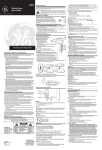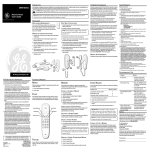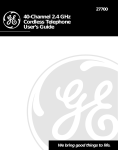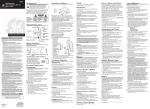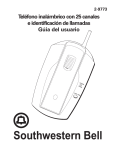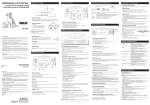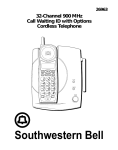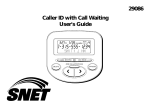Download RCA Model 29318 User's Manual
Transcript
29318 Speakerphone with 12-Number Memory User’s Guide INTRODUCTION Your speakerphone is designed to give you flexibility in use and high quality performance. To get the most from your new telephone, we suggest that you take a few minutes right now to read through this instruction manual. CAUTION RISK OF ELECTRIC SHOCK DO NOT OPEN WARNING: TO PREVENT FIRE OR ELECTRICAL SHOCK HAZARD, DO NOT EXPOSE THIS PRODUCT TO RAIN OR MOISTURE. THE LIGHTNING FLASH AND ARROWHEAD WITHIN THE TRIANGLE IS A WA R N I N G S I G N ALERTING YOU OF "DANGEROUS VOLTAGE" INSIDE THE PRODUCT. CAUTION: TO REDUCE THE RISK OF ELECTRIC SHOCK, DO NOT REMOVE COVER (OR BACK). NO USERS E R V I C E A B L E PA R T S I N SIDE. REFER SERVICING TO QUALIFIED SERVICE PERSONNEL. THE EXCLAMATION POINT WITHIN THE TRIANGLE IS A WARNING SIGN ALERTING YOU OF I M P O R T A N T INSTRUCTIONS A C C O M PA N Y I N G T H E P R O D U C T. SEE MARKING ON BOTTOM / BACK OF PRODUCT Your package should contain the following items: 4 3 6 5 7 8 9 0 STORE STORE ONE TOUCH SPEED DIAL A B C MEMORY DIAL GHI 1 ABC 2 DEF 3 4 JKL 5 MNO 6 7 TUV 8 WXYZ 9 OPER 0 PQRS * TONE # REDIAL/PAUSE FLASH SPEAKER We bring good things to life. Base unit FCC REGISTRATION INFORMATION Your telephone equipment is registered with the Federal Communications Commission and is in compliance with parts 15 and 68, FCC Rules and Regulations. 1 Notification to the Local Telephone Company On the bottom of this equipment is a label indicating, among other information, the FCC Registration number and Ringer Equivalence Number (REN) for the equipment. You must, upon request, provide this information to your telephone company. The REN is useful in determining the number of devices you may connect to your telephone line and still have all of these devices ring when your telephone number is called. In most (but not all) areas, the sum of the RENs of all devices connected to one line should not exceed 5. To be certain of the number of devices you may connect to your line as determined by the REN, you should contact your local telephone company. Notes • This equipment may not be used on coin service provided by the telephone company. • Party lines are subject to state tariffs, and therefore, you may not be able to use your own telephone equipment if you are on a party line. Check with your local telephone company. • Notice must be given to the telephone company upon permanent disconnection of your telephone from your line. 2 Rights of the Telephone Company Should your equipment cause trouble on your line which may harm the telephone network, the telephone company shall, where practicable, notify you that temporary discontinuance of service may be required. Where prior notice is not practicable and the circumstances warrant such action, the telephone company may temporarily discontinue service immediately. In case of such temporary discontinuance, the telephone company must: (1) promptly notify you of such temporary discontinuance; (2) afford you the opportunity to correct the situation; and (3) inform you of your right to bring a complaint to the Commission pursuant to procedures set forth in Subpart E of Part 68, FCC Rules and Regulations. The telephone company may make changes in its communications facilities, equipment, operations of procedures where such action is required in the operation of its business and not inconsistent with FCC Rules and Regulations. If these changes are expected to affect the use or performance of your telephone equipment, the telephone company must give you adequate notice, in writing, to allow you to maintain uninterrupted service. INTERFERENCE INFORMATION This device complies with Part 15 of the FCC Rules. Operation is subject to the following two conditions: (1) This device may not cause harmful interference; and (2) This device must accept any interference received, including interference that may cause undesired operation. This equipment has been tested and found to comply with the limits for a Class B digital device, pursuant to Part 15 of the FCC Rules. These limits are designed to provide reasonable protection against harmful interference in a residential installation. This equipment generates, uses, and can radiate radio frequency energy and, if not installed and used in accordance with the instructions, may cause harmful interference to radio communications. However, there is no guarantee that interference will not occur in a particular installation. If this equipment does cause harmful interference to radio or television reception, which can be determined by turning the equipment off and on, the user is encouraged to try to correct the interference by one or more of the following measures: • • • Reorient or relocate the receiving antenna (that is, the antenna for radio or television that is “receiving” the interference). Reorient or relocate and increase the separation between the telecommunications equipment and receiving antenna. Connect the telecommunications equipment into an outlet on a circuit different from that to which the receiving antenna is connected. If these measures do not eliminate the interference, please consult your dealer or an experienced radio/television technician for additional suggestions. Also, the Federal Communications Commission has prepared a helpful booklet, “How To Identify and Resolve Radio/TV Interference Problems.” This booklet is available from the U.S. Government Printing Office, Washington, D.C. 20402. Please specify stock number 004-000-00345-4 when ordering copies. HEARING AID COMPATIBILITY This telephone system meets FCC standards for Hearing Aid Compatibility. FCC NUMBER IS LOCATED ON THE CABINET BOTTOM REN NUMBER IS LOCATED ON THE CABINET BOTTOM Model 29318GE1-A 15678410 (Rev. 1 E/S) 00-44 Printed in China ATLINKS USA, Inc. 10330 North Meridian Street Indianapolis, IN 46290 © 2000 ATLINKS USA, Inc. Trademark(s) ® Registered Marca(s) Registrada(s) Handset Handset cord 2 4 VOLUME CONTROLS 3 5 7 6 8 9 0 STORE STORE ONE TOUCH SPEED DIAL B A C 6 MEMORY DIAL 1 GHI 4 7 PQRS * TONE ABC 2 DEF 3 JKL 5 MNO 6 TUV 8 WXYZ 9 OPER 0 5 # REDIAL/PAUSE FLASH SPEAKER Phone line cord MODULAR JACK REQUIREMENTS You need an RJ14C or RJ11 type modular jack, which is the most common type of phone jack and might look like the one pictured here. If you don’t have a modular jack, call your local phone company to find out how to get one installed. TEMPORARY TONE FEATURE SPEAKERPHONE BASICS DESKTOP INSTALLATION 1 1. Plug the handset cord into the handset, and into the telephone jack on the left side of the unit. 2. Plug the telephone line cord into a modular jack (RJ11C or RJ14C) and into the PHONE LINE jack on the back of the unit. 3. Adjust the RINGER volume switch to the desired setting. 4. Set the PULSE/TONE switch to TONE if you use Touch-Tone service; set it to PULSE if you have rotary service. 5. The unit is properly installed if you pick up the handset and hear the dial tone. Otherwise, recheck all the installation steps. Redial the last number you called by pressing the REDIAL button after you get a dial tone. MAKING A CALL Store as many as 12 numbers in memory for easy dialing. Three can be stored in the Emergency Quick Dial locations, and ten additional numbers can be stored in the numbered keys (0-9). 1. Press the SPEAKER button instead of picking up the handset when the phone rings. 2. Adjust volume if needed. 3. Press SPEAKER again to hang up the phone. SWITCHING BETWEEN SPEAKER AND HANDSET You can switch between speakerphone and handset while the phone is dialing a number, or anytime during a conversation. • Speaker to Handset — Pick up the handset. • Handset to Speaker — Press SPEAKER, then hang up handset. NOTE: The Redial feature holds in memory the last phone number you dialed (as many as 31 digits). If you pressed any numbers after dialing the phone number, (for example, when accessing a voice-menu system) those numbers also are redialed. TELEPHONE BASICS 1. 2. 3. 4. 5. Press SPEAKER (or pick up the handset). Press STORE. Dial the number to be stored (up to 16 digits). Press STORE button. Press a Memory Location (0-9 on the keypad), or an EMERGENCY QUICK DIAL button. 6. Press SPEAKER (or hang up the handset). 7. Record the phone number on the memory directory (located under the plastic cover). ADDING A PAUSE TO THE DIALING SEQUENCE Use the REDIAL button to insert a delay in the dialing sequence when storing a number, for example, when you need to dial 9 to get an outside line. Press REDIAL at the point in the dialing sequence in which a pause is required. EMERGENCY QUICK DIAL buttons DIALING A NUMBER FROM MEMORY 1 You can wrap any extra phone cord to get it out of the way. 2 You can dial numbers from memory when using the handset or speakerphone. When you get a dial tone, press the MEMORY DIAL button followed by the memory location (0-9) for the number you want to dial. 3 4 5 6 7 8 9 MEMORY DIAL button 0 STORE STORE WALL MOUNT INSTALLATION ONE TOUCH SPEED DIAL A B C MEMORY DIAL TONE button GHI Speakerphone indicator 1 ABC 4 JKL 7 TUV OPER 0 PQRS * TONE 2 DEF 3 5 MNO 6 8 WXYZ 9 SPEAKER FLASH button SPEAKER button # REDIAL/PAUSE FLASH RINGER volume switch REDIAL/PAUSE button IMPORTANT: If you make test calls to emergency numbers, remain on the line and explain the reason for the call. Also, make these calls in off-peak hours, such as early morning or late evening. TONE/ PULSE switch HANDSET RECEIVER volume control switch SPEAKER volume control To dial one of these numbers, just press its button after you get a dial tone. CHAIN DIALING FROM MEMORY Use this feature to make calls which require a sequence of numbers, for instance if you use a calling card for a frequently called long distance number. Basically, you dial each part of the sequence from memory. The following example shows how you can use chain dialing to make a call through a long distance service: The Number For Memory Location Long distance access number Authorization code Frequently called long distance number 7 8 9 1. Press SPEAKER (or pick up the handset). 2. Press the MEMORY DIAL button and then press 7. 3. When you hear the access tone, press MEMORY DIAL and then press 8. 4. At the next access tone, press MEMORY DIAL and then 9. TROUBLESHOOTING GUIDE Problem Solution No dial tone. Won't dial out • Check hook switch to make sure it pops up. • Make sure speakerphone indicator comes on (if using speakerphone.) • Make sure TONE/PULSE is set to correct position. • Unplug the phone, wait 30 seconds, and plug the phone back in. Then lift the handset to check the dial tone. Phone doesn’t ring • Check RINGER volume. • Could have too many phones on one line. (The total REN of all phones should not be greater than the maximum REN for your calling area, Usually 5.) Low handset or speaker volume • Check the volume settings. STORING A NUMBER IN MEMORY Change a stored number by replacing it with a different number. STORE button DIALING THE EMERGENCY QUICK DIAL NUMBERS MEMORY CHANGING A STORED NUMBER PHONE CORD WRAP The speakerphone can be mounted on a wall phone plate (not included). 3 1. Plug the phone cord into the phone jack on the back 1 of the unit, and wrap the extra phone line around 2 the bottom of the base. 2. Connect the phone line to the modular jack on the wall. 3. Slip the mounting holes over the wall plate posts and slide the unit down firmly into place. Press the FLASH button instead of using the hook switch to activate customer calling services such as call waiting or call transfer, which are provided by your local phone company. Note the following guidelines when using the speakerphone: • The speakerphone works similar to a two-way radio in that you can only listen or talk at one time. • Stay reasonably close to the phone so that you can be clearly heard by the person to whom you are talking. • You can adjust the speaker volume by sliding the VOLUME control on the right side of the base unit. • The speakerphone indicator comes on when the speakerphone is in use. Make sure that the RINGER switch is set to HI or LO or the phone will not ring. 2 FLASH REDIAL RECEIVING A CALL 3 If you have Pulse (rotary) service, and want to access customer calling services that require Tone dialing, such as getting information from a local bank, you can use this feature. 1. Press the tone button ( * ) after you have connected to the service to enable Tone dialing. 2. When you hang up, the phone automatically returns to Pulse dialing mode. SPEAKERPHONE USE 1. Press the SPEAKER button instead of picking up the handset. 2. Adjust volume if needed. 3. Make your call. 4. Press SPEAKER again to hang up the phone. INSTALLATION Control the volume of both the handset and the speakerphone: • Use the SPEAKER volume control to adjust speakerphone volume. • Use the HANDSET RECEIVER volume control to adjust the handset volume. 4 For best speakerphone performance, avoid the following: • Areas with high background noise. (The microphone might pick up these sounds and prevent the speakerphone from going into the receiving mode when you finish talking.) • Surfaces affected by vibration. • Recessed areas such as in a corner, under a cupboard, or next to a cabinet, which can generate an echo effect. PARTS CHECKLIST 2 1 SPEAKERPHONE LOCATION BEFORE YOU BEGIN 1 4. Plug the handset line into the unit, then hang up the phone. 5. Set the PULSE/TONE switch to TONE if you use Touch-Tone service; set it to PULSE if you have rotary service. 6. Set the RINGER VOLUME switch as desired. 7. The unit is properly installed if you pick up the handset and hear the dial tone. Otherwise, recheck all installation steps. Light and tone • This is normal as power is feedback flutter when fluctuating with phone dialing in PULSE mode. outpulsing. Can’t be heard by other party • Make sure phone cord is securely plugged in. Memory dialing • Make sure you entered numbers correctly. (See "Memory.") GENERAL PRODUCT CARE To keep your telephone working and looking good, follow these guidelines: • Avoid putting it near heating appliances and devices that generate electrical noise (for example, motors or fluorescent lamps). • DO NOT expose to direct sunlight or moisture. • Avoid dropping and other rough treatment to the answerer. • Clean with a soft cloth. • Never use a strong cleaning agent or abrasive powder because this will damage the finish. • Retain the original packaging in case you need to ship it at a later date. SERVICE FCC requires this product to be serviced only by the manufacturer or its authorized service agents. In accordance with FCC requirements, changes or modifications not expressly approved by ATLINKS USA could void the user’s authority to operate this product. For instructions on how to obtain service, call Consumer Information, 1-800-448-0329. Attach your sales receipt to the booklet for future reference or jot down the date this product was purchased or received as a gift. This information will be valuable if service should be required during the warranty period. Purchase date___________________________________________ Name of store___________________________________________ LIMITED WARRANTY What your warranty covers: • Any defect in materials or workmanship. For how long after your purchase: • One year. (The warranty period for rental units begins with the first rental or 45 days from date of shipment to the rental firm, whichever comes first.) What we will do: • Provide you with a new or, at our option, a refurbished unit. • The exchange unit is under warranty for the remainder of the original product’s warranty period. How to make a warranty claim: • Properly pack your unit. Include any cables, etc., which were originally provided with the product. We recommend using the original carton and packing materials. • Include evidence of purchase date such as the bill of sale. Also print your name and address and a description of the defect. Send via standard UPS or its equivalent to: Thomson Consumer Electronics, Inc. 11721 B Alameda Ave. Socorro, Texas 79927 • Pay any charges billed to you by the Exchange Center for service not covered by the warranty. • Insure your shipment for loss or damage. Thomson accepts no liability in case of damage or loss en route to Thomson. • A new or refurbished unit will be shipped to you freight prepaid. What your warranty does not cover: • Customer instruction. (Your Owner’s Manual provides information regarding operating instructions and user controls. For additional information, ask your dealer.) • Installation and set-up service adjustments. • Batteries. • Damage from misuse or neglect. • Products which have been modified or incorporated into other products. • Products purchased or serviced outside the USA. • Acts of nature, such as but not limited to lightning damage. Product Registration: • Please complete and mail the Product Registration Card packed with your unit. It will make it easier to contact you should it ever be necessary. The return of the card is not required for warranty coverage. How state law relates to this warranty: • This warranty gives you specific legal rights, and you may have other rights which vary from state to state. If you purchased your product outside the USA: • This warranty does not apply. Contact your dealer for warranty information. 29318 Teléfono con Altavoz y Memoria de 12 Números Guía del Usuario INTRODUCCIÓN 1 STORE Su teléfono con altavoz está diseñado para darle flexibilidad de uso y la más alta calidad de funcionamiento. Para aprovechar al máximo su nuevo teléfono, le sugerimos que se tome unos minutos ahora mismo para leer este manual de instrucciones. ADVERTENCIA: PARA PREVENIR EL RIESGO DE UNFUEGO O DE UNA SACUDIDA ELECTRICA, NO EXPONGA ESTE APARATO A LA LLUVIA O A LA HUMEDAD. EL RELÁMPAGO Y LA PUNTA DE FLECHA DENTRO DEL TRIÁNGULO ES UNA SEÑAL DE ADVERTENCIA, ALERTÁNDOLE A UD. DE QUE HAY "VOLTAJE PELIGROSO" DENTRO DEL PRODUCTO. CUIDADO: PARA REDUCIR EL RIESGO DE UNA SACUDIDA ELÉCTRICA, NO QUITE LA CUBIERTA (O PARTE POSTERIOR) NO USE PARTES DE REPUESTO DENTRO. CONSULTE A ALGUNA PERSONA CALIFICADA DEL SERVICIO DE REPARACIONES. EL SIGNO DE EXCLAMACIÓN DENTRO DEL TRIÁNGULO ES UNA SEÑAL DE ADVERTENCIA, ALTERTÁNDOLE A UD. DE QUE EL PRODUCTO, TRAE INCLUCIDO, IN STRUCTIONES MUY IMPORTANTES. VEA ADVERTENCIA EN LA PARTE POSTERIOR/BASE DEL PRODUCTO. ANTES DE COMENZAR Su empaque debe contener los siguientes artículos: 1 2 3 4 5 6 8 9 7 0 STORE STORE ONE TOUCH SPEED DIAL A B C MEMORY DIAL 1 GHI 4 7 PQRS * TONE ABC 2 DEF 3 JKL 5 MNO 6 TUV 8 WXYZ 9 OPER 0 # REDIAL/PAUSE FLASH SPEAKER Base INFORMACIÓN DE INTERFERENCIAS Este artefacto cumple con la Parte 15 de las Reglas de la FCC. Su funcionamiento es sujeto a las dos condiciones siguientes: (l) Este artefacto no puede causar interferencia dañosa, y (2) Este artefacto debe aceptar cualquier interferencia recibida, incluyendo interferencia que puede causar un funcionamiento no deseado. Este equipo ha sido probado y cumple con los límites para un artefacto digital de la Clase B, de conformidad con la Parte 15 de las Reglas de la FCC. Estos límites han sido diseñados para proporcionar una protección razonable contra una interferencia dañosa que pueda existir en una instalación doméstica. Este equipo genera, usa y puede radiar la energía de frecuencia de una radio y, si no fuera instalado y usado de acuerdo con las instrucciones, puede causar interferencia dañosa a las transmisiones radiales. Sin embargo, no hay garantía que la interferencia no ocurrirá en una instalación en particular. Si este equipo causa en efecto una interferencia dañosa a la recepción de la radio o de la televisión, lo cual puede ser determinado apagando y prendiendo el equipo, le animamos a Ud. de tratar de corregir la interferencia por medio de una (o más) de las sugerencias siguientes: • Cambie la posición o la ubicación de la antena (quiere decir la antena de la radio o de la televisión que está recibiendo la interferencia). • Cambie la posición o cambie la ubicación y aumente la distancia entre el equipo de telecomunicaciones y la antena receptora de la radio o de la televisión que está recibiendo la interferencia. • Conecte el equipo de telecomunicaciones a una toma en un circuito diferente del circuito al cual la antena receptora esté conectada. Si estas medidas no eliminan la interferencia, favor de consultar a su distribuidor o a un técnico de radio/televisión experto por otras sugerencias. También, la Comisión Federal de Comunicaciones (FCC) ha preparado un folleto muy útil, “How To Identify and Resolve Radio/TV Interference Problems” (“Como Identificar y Resolver Problemas de Interferencia de Radio/Televisión”). Este folleto se puede obtener del U.S. Goverment Printing Office, Washington, D.C. 20402. Favor de especificar el número 004-000-00345-4 cuando haga su pedido. COMPATIBILIDAD CON AUDÍFONOS Se juzga que este teléfono es compatible con audífonos, en base a las normas de la FCC. El número de la FCC está ubicado en el fondo de la base El numero REN esta ubicado en el fondo de la base Modelo 29318GE1-A 15678410 (Rev. 1 E/S) 00-44 Impreso en China ATLINKS USA, Inc. 10330 North Meridian Street Indianapolis, IN 46290 © 2000 ATLINKS USA, Inc. Trademark(s) ® Registered Marca(s) Registrada(s) Auricular Cable del auricular STORE 6 CONTROLES DE VOLUMEN 9 ONE TOUCH SPEED DIAL B A C MEMORY DIAL ABC DEF JKL MNO PQRS TUV WXYZ TONE OPER GHI REDIAL/PAUSE FLASH SPEAKER FUNCIONES BÁSICAS DEL ALTAVOZ LISTA DE PARTES Su equipo telefónico de la ha sido registrado con la Comisión Federal de Comunicaciones (FCC) y está en acuerdo con las Partes 15 y 68 de las Regulaciones y Reglas de la FCC. 1 Notificación a la Compañía Telefónica Local Al fondo de este equipo Ud. hallará un rótulo indicando, entre otra información, el número de la Registración con la FCC y el Número del Equivalente Timbre (REN) para este equipo. Ud. deberá, a petición, proveer esta información a su compañía telefónica. El REN es útil para determinar el número total de artefactos que Ud. puede conectar a su línea telefónica, todavía asegurando que todos estos artefactos sonarán cuando se llame su número telefónico. En la mayoría de las áreas (pero no en todas), el total de los números REN de todos los artefactos conectados a una línea no debe exceder 5. Para estar seguro del número total de artefactos que Ud. pueda conectar a su línea (determinado por el REN), Ud. deberá ponerse en contacto con su compañía telefónica local. NOTAS: • No se puede usar este equipo con un teléfono de previo pago proveído por la compañía telefónica. • Las líneas compartidas son sujetas a las tarifas del estado, y por eso, es posible que Ud. no pueda usar su propio equipo telefónico si Ud. estuviera compartiendo la misma línea telefónica con otros abonados. • Se debe notificar la compañía telefónica cuando se desconecte permanentemente su teléfono de la línea. 2 Derechos de la Compañía Telefónica Si su equipo causase algún problema en su línea que pudiera dañar la red telefónica, la compañía telefónica siempre que sea posible le avisará de la posible interrupción temporal de su servicio. En caso que la compañía no pudiera avisarle de antemano y hubiera necesidad de tomar tal acción, la compañía telefónica podrá interrumpir su servicio inmediatemente. En caso de tal interrupción telefónica temporal la compañía debe : (1) darle aviso al momento de tal interrupción temporal de servico, (2) concederle a Ud. la oportunidad de corregir la situación, (3) informarle a Ud. de sus derechos de presentar una questa a la Comisión de acuerdo con los procedimientos dictados en la Subparte E de la Parte 68 de las Regulaciones y Reglas de la FCC. La compañía telefónica puede hacer los cambios en sus instalaciones de comunicación, en equipos, en sus funcionamientos o procedimientos que digne necesarios para el manejo de sus negocios y que no sean incompatibles con las Reglas y Regulaciones de l a FCC. Si estos cambios pudieran alterar el uso o el funcionamiento de su equipo telefónico, la compañía telefónica deberá darle aviso adecuado en escrito para que Ud. goce de un servico ininterrumpido. 3 5 8 0 ATTENTION: INFORMACIÓN DEL REGISTRO A LA FCC 2 4 7 RIESGO DE SACUDIDA ELÉCTRICA NO ABRA Creamos cosas buenas para la vida. 4. Conecte el cable del auricular al aparato, y cuelgue el teléfono. 5. Programe el selector de pulso/ 6 tono (“PULSE/TONE”) en la 2 3 1 4 5 6 posición de tono (“TONE”) si 5 7 8 9 usted quiere usar su aparato en # 0 * modalidad para marcar por tono; colóquelo en la posición de pulso (“PULSE”) si usted 4 tiene servicio rotatorio. 6. Programe el selector de volumen (“RINGER VOLUME”) en el nivel deseado. 7. El aparato esté instalado adecuadamente si usted levanta el auricular y escucha el tono de marcar. De otra manera, verifique los pasos de instalación. Cable de línea telefónica REQUERIMIENTOS PARA ENCHUFE MODULAR Usted necesita un enchufe modular tipo RJ14C o RJ11, que es el tipo de enchufe telefónico más común y se parece al enchufe ilustrado aquí. Si usted no tiene un enchufe modular, llame a su compañía telefónica para informarse cómo se le puede instalar uno. INSTALACIÓN 3 LOCALIZACIÓN DEL ALTAVOZ Para el mejor funcionamiento del altavoz, evite lo siguiente: • Áreas con mucho ruido de fondo. (El micrófono puede recoger estos sonidos y evitar que el altavoz pueda cambiarse a la modalidad para recibir cuando usted termina de hablar). • Superficies afectadas por vibración. • Areas remetidas, como una esquina, abajo de una gaveta, o junto a un gabinete, los cuales pueden generar un efecto de eco. USO DEL ALTAVOZ Siga las siguientes pautas cuando utilice el altavoz: • El altavoz funciona en una forma similar a un radio bidireccional, en que usted puede únicamente escuchar o hablar al mismo tiempo. • Quédese razonablemente cerca del teléfono para que pueda ser escuchado claramente por la persona con la que está hablando. • Usted puede ajustar el volumen del altavoz, simplemente deslizando el selector de volumen (“VOLUME”), al costado derecho del aparato. • El indicador luminoso del altavoz se encenderá cuando el altavoz está siendo utilizado. CÓMO HACER UNA LLAMADA 1 2 INSTALACIÓN SOBRE SUPERFICIE PLANA 1. Oprima el botón para el altavoz (“SPEAKER”) en lugar de levantar el auricular. 2. Ajuste el volumen si es necesario. 3. Haga su llamada. 4. Oprima nuevamente el botón del altavoz (“SPEAKER”) para colgar el teléfono. 1. Conecte el cable telefónico en el auricular, y al enchufe telefónico que se encuentra al costado izquierdo del aparato. 2. Conecte el cable de línea telefónica dentro del contacto modular (RJ11C o RJ14C) y dentro del enchufe marcado “PHONE LINE” en la parte trasera del aparato. 3. Ajuste el selector de volumen del timbre (“RINGER”) a la posición deseada. 4. Programe el selector de pulso/ tono (“PULSE/TONE”) en la posición de tono (“TONE”) si usted quiere usar su aparato en modalidad para marcar por tono; colóquelo en la posición de pulso (“PULSE”) si usted tiene servicio rotatorio. 5. El aparato esté instalado adecuadamente si usted levanta el auricular y escucha el tono de marcar. De otra manera, verifique los pasos de instalación. CÓMO RECIBIR UNA LLAMADA ALMACENAJE DEL CABLE TELEFÓNICO FUNCIONES BÁSICAS DEL TELÉFONO Usted puede enhebrar el cable telefónico adicional para que no estorbe. Botones para marcar números de emergencia (“EMERGENCY QUICK DIAL”) Botón para almacenar (“STORE”) Botón para Botón marcar por para memoria marcar (“MEMORY por tono DIAL”) (“TONE”) Selector de tono/pulso Indicador de 1 2 3 (“TONE/ altavoz PULSE”) 4 5 6 INSTALACIÓN SOBRE PARED El teléfono con altavoz puede ser montado en una placa para montaje (no incluida). 1. Conecte el cable telefónico en un enchufe modular en la parte 3 trasera del aparato, y enrede el cable adicional alrededor de la parte de 1 abajo de la base. 2 2. Conecte el cable de la línea telefónica al enchufe modular de pared. 3. Deslice los agujeros para montaje sobre la placa de pared y deslice el aparato hacia abajo firmemente a que quede en su sitio. Asegúrese de que el selector del timbre (“RINGER”) está programado en “HI” o “LO” porque de otra manera el teléfono no timbrará. 1. Oprima el botón para el altavoz (“SPEAKER”) en lugar de levantar el auricular cuando el teléfono timbre. 2. Ajuste el volumen si es necesario. 3. Oprima nuevamente el botón del altavoz (“SPEAKER”) para colgar el teléfono. PARA INTERCAMBIAR ENTRE ALTAVOZ Y AURICULAR Usted puede intercambiar entre altavoz y auricular mientras el teléfono está marcando un número, o en cualquier momento durante una conversación. • De Altavoz a Auricular- Levante el auricular. • De Auricular a Altavoz- Oprima el botón “SPEAKER”, y después cuelgue el auricular. 1 2 3 4 5 6 7 8 9 0 STORE ONE TOUCH SPEED DIAL STORE B A C MEMORY DIAL GHI Botón para servicios (“FLASH”) 7 PQRS * TONE ABC DEF JKL MNO TUV 8 OPER 0 9 # REDIAL/PAUSE FLASH Botón para altavoz (“SPEAKER”) Botón para volver a marcar (“REDIAL/PAUSE”) WXYZ Selector del timbre (“RINGER”) SPEAKER Controlan el volumen tanto del auricular como del altavoz: • Utilice el control de volumen del altavoz (“SPEAKER”) para ajustar el volumen del altavoz. • Utilice el control de volumen del recibidor del auricular (“HANDSET RECEIVER”) para ajustar el volumen del auricular. FUNCIÓN DE TONO TEMPORAL PARA MARCAR Si usted tiene servicio de pulso (rotatorio) para marcar, y quiere tener acceso a servicios telefónicos que requieren la modalidad para marcar por tono, como por ejemplo transacciones bancarias, usted puede utilizar esta función. 1. Oprima el botón de tono (*) después de que se ha conectado al servicio, para habilitar el marcado por tono. 2. Cuando usted cuelga, el teléfono regresa automáticamente a la modalidad para marcar por Pulso. Para marcar uno de estos números, simplemente oprima el botón correspondiente después de que escucha el tono de marcar. CÓMO MARCAR EN CADENA DESDE LA MEMORIA Utilice esta función para hacer llamadas que requieren una secuencia de números, por ejemplo si usted usa una tarjeta para llamar frecuentemente a un número de larga distancia. Básicamente, usted marca cada parte de la secuencia desde la memoria. El siguiente ejemplo le muestra cómo usted puede marcar desde la memoria para hacer una llamada a través de un servicio de larga distancia: SERVICIOS ESPECIALES (“FLASH”) El Número Para Oprima el botón “FLASH” en lugar de usar el gancho para colgar para poder activar los servicios especiales como llamada en espera o transferencia de llamada, que son provistos por su compañía telefónica. Número de acceso a la compañía de larga distancia Clave de autorización Número de larga distancia llamado frecuentemente VOLVER A MARCAR (“REDIAL”) Vuelva a marcar el último número al que usted llamó, oprimiendo el botón “REDIAL” una vez que obtiene tono de marcar. NOTA: La función de Volver a Marcar (“REDIAL”) retiene en la memoria el último número que usted marcó (hasta 31 dígitos). Si usted oprimió cualquier tecla después de marcar el número telefónico (por ejemplo, para tener acceso a un sistema de menú de voz), esos números también serán marcados). MEMORIA Usted puede almacenar hasta 12 números en memoria para marcado rápido. Tres pueden ser almacenados en localizaciones para la memoria de números de emergencia (Emergency Quick Dial), y diez números adicionales pueden ser almacenados en las teclas numéricas (0-9). CÓMO ALMACENAR UN NÚMERO EN LA MEMORIA 1. Oprima el botón de altavoz (“SPEAKER”) (o levante el auricular). 2. Oprima el botón para almacenar (“STORE”). 3. Marque el número que será almacenado (hasta 16 dígitos). 4. Oprima nuevamente el botón para almacenar (“STORE”). 5. Oprima una Localización de Memoria (0-9 en el teclado), o un número de localización de los números de emergencia (“EMERGENCY QUICK DIAL”). 6. Oprima el botón de altavoz (“SPEAKER”) (o cuelgue el auricular). 7. Anote el número telefónico en el directorio de memoria (abajo de la cubierta de plástico). CÓMO INTRODUCIR UNA PAUSA EN LA SECUENCIA DE MARCAR Utilice el botón “REDIAL” para introducir una pausa en la secuencia cuando almacena un número, por ejemplo, cuando usted debe marcar el 9 para obtener línea externa. Oprima el botón “REDIAL” en el momento de la secuencia de marcado en el que la pausa es requerida. CÓMO CAMBIAR UN NÚMERO ALMACENADO Cambie un número almacenado simplemente reemplazándolo con un número diferente. CÓMO MARCAR UN NÚMERO DE LA MEMORIA Usted puede marcar números de la memoria cuando utiliza el auricular o el altavoz. Cuando usted obtiene tono de marcar, oprima el botón “MEMORY/DIAL”, seguido por la localización de memoria (0-9) del número que usted quiere marcar. IMPORTANTE: Si usted hace llamadas de prueba a números de emergencia, permanezca en la línea y explique brevemente al operador el motivo de su llamada. También, es una buena idea hacer estas llamadas en horas menos congestionadas, como temprano por la mañana o tarde por la noche. Control de volumen del recibidor del auricular (“HANDSET RECEIVER”) Control de volumen del altavoz (“SPEAKER”) CÓMO MARCAR LOS NÚMEROS DE EMERGENCIA (“EMERGENCY QUICK DIAL”). Localización en la Memoria 7 8 9 1. Oprima el botón “SPEAKER” (o levante el auricular). 2. Oprima el botón “MEMORY DIAL” y después oprima 7. 3. Cuando escuche el tono de acceso, oprima el botón “MEMORY DIAL” y después oprima 8. 4. Al siguiente tono de acceso, oprima el botón “MEMORY DIAL” y después oprima 9. SOLUCIÓN DE PROBLEMAS Problema Explicación/Solución No hay tono de marcar • Verifique que le gancho para No da línea colgar rebote hacia arriba. • Asegúrese de que el indicador del altavoz se ilumina (si está usando el altavoz). • Asegúrese de que el selector de tono/ pulso (“TONE/PULSE”) esté en la posición correcta. • Desconecte el teléfono, espere 30 segundos, y vuelva a conectarlo. Después, levante el auricular para ver si da línea. El teléfono no timbra • Verifique el nivel de volumen del timbre (“RINGER”). • Puede haber demasiadas extensiones del teléfono en su línea. (El número total de REN de todos los teléfonos no debería ser mayor que el número de REN para su área. Por lo general es 5). Volumen del auricular • Verifique el nivel de volumen. y altavoz muy bajos El indicador y el tono • Esto es normal, porque la corriente fluctúa mientras el de alimentación parpadean mientras se teléfono marca. marca en modalidad de pulso. A usted no le escucha la otra otra persona • ¿Está el cable telefónico conectado adecuadamente? La función de marcar • Asegúrese de que inscribió los números correctamente. (Vea la sección “Memoria”). CUIDADO GENERAL DEL PRODUCTO Para mantener su teléfono funcionando bien y con buena apariencia, observe las siguientes pautas: • Evite poner el teléfono cerca de calentadores (calefactores) de ambiente y dispositivos que generen interferencia eléctrica ejemplo, motores o lámparas fluorescentes). • No lo exponga a la luz solar directa o a la humedad. • No deje caer la extensión móvil y no maltrate el teléfono. • Limpie el teléfono con un trapo suave • Nunca use un agente de limpieza fuerte ni un polvo abrasivo, ya que esto dañará el acabado. • Retenga el empaque original en caso de que necesite embarcar el auricular en el futuro. CÓMO OBTENER SERVICIOS DE MANTENIMIENTO La FCC requiere que este producto sea sometido a servicios de mantenimiento solamente por el fabricante o por sus agentes de servicio autorizados. De acuerdo con los requerimientos de la FCC, los cambios o las modificaciones que no hayan sido expresamente aprobadas por ATLINKS USA podrían anular la autoridad que tiene el usuario de operar este producto. Para recibir instrucciones sobre cómo obtener servicios de mantenimiento, por favor consulte la garantía incluida en esta Guía, o llame a Información para el Usuario, 1-800-448-0329. Adjunte su recibo al folleto, para futura referencia, o anote la fecha en la que se compró o recibió este producto como regalo. Esta información será valiosa si se llegase a requerir durante el período de garantía. Fecha de compra________________________________________ Nombre de la tienda_____________________________________ GARANTÍA LIMITADA Lo que cubre su garantía: • Cualquier defecto en material o mano de obra. Por cuánto tiempo después de la compra: • Un año. (El periodo de garantía para unidades arrendadas se inicia con la primera renta o 45 días de la fecha del embarque a la firma de arrendamiento, lo que ocurra primero). Lo que haremos: • Proporcionarle una unidad nueva o, a nuestra opción, una reacondicionada. • La unidad de intercambio quedará bajo garantía por el resto del periodo de garantía del producto original. Cómo hacer un reclamo de garantía: • Empaque bien la unidad, incluyendo todos los cables, etc., que originalmente venían con el producto. Se recomienda usar el cartón y materiales de empaque originales. • Incluya evidencia de la fecha de compra, como el recibo de pago. También escriba claramente su nombre, dirección y la descripción del defecto. Mande vía UPS o un servicio de paquetería equivalente a: Thomson Consumer Electronics, Inc. 11721 B Alameda Ave. Socorro, Texas 79927 • Pague cualquier cargo que le facture el Centro de Intercambio por servicio que no esté cubierto por garantía. • Asegure su paquete contra pérdida o daños. Thomson no acepta responsabilidad en caso de daños o pérdida durante el trayecto a Thomson. • Un aparato nuevo o uno remozado se le enviará con los cargos pagados. Lo que no cubre la garantía: • Instrucciones al cliente. (Su manual de propietario le proporciona la información con respecto a las instrucciones de operación y los controles del usuario. Para información adicional, pregunte a su distribuidor). • Ajustes de instalación y de preparación del servicio. • Baterías. • Daño por mal uso o negligencia. • Productos que han sido modificados o incorporados a otros productos. • Productos comprados o que han recibido servicio fuera de los Estados Unidos. • Desastres naturales, por ejemplo y sin limitarse a ellos, daños por relámpagos. Registro del Producto: • Por favor llene y envíe por correo la Tarjeta de Registro del Producto que se embarcó con su producto. Hará más fácil que hagamos contacto con usted si fuera necesario. No se requiere la devolución de la tarjeta para tener la cobertura de la garantía. Cómo se Relaciona la Ley Estatal a esta Garantía: • Esta garantía le da a usted derechos legales específicos y podrá tener otros derechos que varían de estado a estado. Si compró su producto fuera de los Estados Unidos: • Esta garantía no se aplica. Vea a su distribuidor para información sobre la garantía.
This document in other languages
- español: RCA Model 29318





